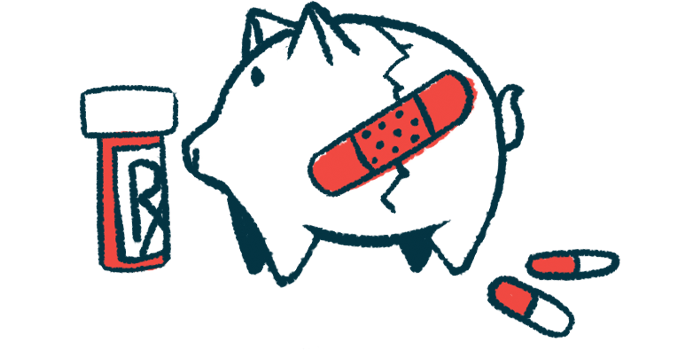Economic burden in PAH mainly due to treatment, hospital costs
Healthcare costs over 8 times higher for PAH vs. other patients: Study

Healthcare costs were found to be more than eight times higher for people with pulmonary arterial hypertension (PAH) compared with patients without the disease in a real-world study — which contributed to the greater economic burden seen for those being treated for PAH.
These costs were mainly driven by expenses in PAH medications and hospitalizations, which increased significantly in the last months of patients’ lives, according to the study, led by scientists from Merck & Co. and IQVIA, a clinical research services company.
Overall, higher costs were primarily related to hospitalizations, indicating a higher care burden.
“The findings from this study suggest that PAH imposes substantial economic burden on the US healthcare system,” the researchers wrote.
“Whether better management of the underlying disease, through improvements in time to diagnosis, adherence to treatment guidelines, or use of next‐generation medications in patients might help abrogate these costs warrants further consideration,” the team added.
The study, “Excess healthcare resource utilization and costs for commercially insured patients with pulmonary arterial hypertension: A real-world data analysis,” was published in Pulmonary Circulation. It was funded by a Merck & Co. subsidiary.
Investigating the economic burden of PAH in the US
PAH is a type of pulmonary hypertension (PH) characterized by the narrowing of the pulmonary arteries. These blood vessels transport blood through the lungs, and such narrowing restricts blood flow and causes high blood pressure, known as hypertension.
In the U.S., the disease has been estimated to affect 109 patients per million adults ages 19-64, and 451 patients per million adults 65 and older. PAH has been associated with a substantial economic burden, at least in part due to delays in diagnosis and treatment initiation.
To estimate the real-world burden of the disease, scientists from the two companies, along with a researcher from Inova Fairfax Hospital, in Virginia, compared healthcare resource utilization and associated costs in commercially insured PAH patients to matched patients without PH. The team also explored the disease burden in PAH patients near the end of life. For that, they analyzed data from a health plan database in the U.S.
A total of 386 adults with PAH and 3,669,925 without any form of PH were identified as being treated between October 2014 and May 2020, or through March 2022 for end-of-life patients.
Overall, those with PAH were older than the group without PH (mean age 50.9 vs. 42.5 years), and had a higher mean Charlson Comorbidity Index (CCI) score (1.9 vs. 0.3). That score is an indication of mortality risk and the severity of comorbidities, or coexisting conditions. Also, the PAH patients had a higher frequency of lung infections (25.9% vs. 9.1 %).
The average healthcare costs were found to be significantly higher for those with PAH, with a mean healthcare cost of $2,914 per patient per month versus $297.
Next, the total group of PAH patients was matched to the same number of patients without PH, based on age, sex, payer type, plan type, CCI score, cardiovascular disorders, and other demographic and clinical characteristics.
As expected, shortness of breath, a PAH hallmark, was more common among PAH patients than those without PH, with rates of 67.6% versus 22.5%. Other issues also occurred more frequently among the PAH patients relative to those without the condition, including lung swelling, found in 4.9% versus 2.1%, coronary heart disease — when the heart arteries cannot deliver enough oxygen to the heart — as seen in 21.2% versus 16.1%, and alcohol-related disorders, seen for 6% versus 2.1%.
In contrast, hypertension (59.1% vs. 65.5%) and obesity (71.2% vs. 80.4%) were less frequent in the PAH group. Mean healthcare costs also remained higher in the PAH group ($3,069 vs. $1,571 per patient per month).
Total healthcare costs average $180K vs. $20K, per study
Patients were followed up to a median of 22.9 months or almost two years in the PAH group, and for slightly less time, 21.5 months, in the non-PH group. During follow-up, PAH patients had a higher rate of medical service use, including hospitalization — about 18% were hospitalized at least once in a year — and visits to the emergency department or as outpatients.
The risk of hospitalization due to any cause was almost seven times higher among PAH patients. This group’s median length of hospital stay (6.7 vs. 2.4 days) also was longer than that of non-PAH patients.
Total healthcare costs were more than eight times higher in PAH patients ($183,616 vs. $20,212). These were mainly due to pharmacy costs ($115,926 vs. $7,862), which were 14 times higher in these patients and accounted for 63.1% of all costs. Hospitalizations were associated with 20% of all costs.
The study findings indicate substantial [healthcare resource utilization] and costs for PAH. While pharmacy costs were one of the major sources, hospitalization was the primary driver for [end of life]-related costs.
Among 28 patients who had died, 60.7% had at least one hospitalization within 30 days of death. That percentage was higher (82.1%) when considering six months before death.
Their mean healthcare costs per patient were $48,846 in the month before death, and $167,524 when looking at the six months before these individuals died. Hospitalizations were the main driver of these costs.
“The study findings indicate substantial [healthcare resource utilization] and costs for PAH. While pharmacy costs were one of the major sources, hospitalization was the primary driver for [end of life]-related costs,” the researchers wrote.
According to the team, this “retrospective database study provides a contemporary estimate of the economic burden of patients with PAH compared to patients without PH.”









